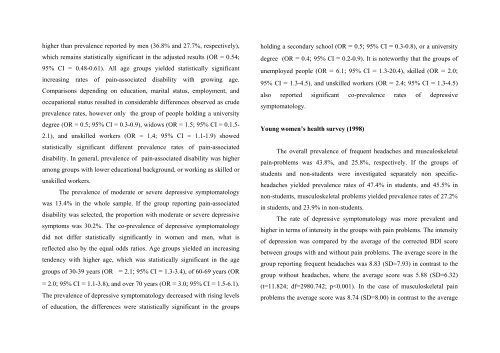János M. Réthelyi MD Semmelweis University, 4th Interdisciplinary ...
János M. Réthelyi MD Semmelweis University, 4th Interdisciplinary ... János M. Réthelyi MD Semmelweis University, 4th Interdisciplinary ...
higher than prevalence reported by men (36.8% and 27.7%, respectively), which remains statistically significant in the adjusted results (OR = 0.54; 95% CI = 0.48-0.61). All age groups yielded statistically significant increasing rates of pain-associated disability with growing age. Comparisons depending on education, marital status, employment, and occupational status resulted in considerable differences observed as crude prevalence rates, however only the group of people holding a university degree (OR = 0.5; 95% CI = 0.3-0.9), widows (OR = 1.5; 95% CI = 0.1.5- 2.1), and unskilled workers (OR = 1.4; 95% CI = 1.1-1.9) showed statistically significant different prevalence rates of pain-associated disability. In general, prevalence of pain-associated disability was higher among groups with lower educational background, or working as skilled or unskilled workers. The prevalence of moderate or severe depressive symptomatology was 13.4% in the whole sample. If the group reporting pain-associated disability was selected, the proportion with moderate or severe depressive symptoms was 30.2%. The co-prevalence of depressive symptomatology did not differ statistically significantly in women and men, what is reflected also by the equal odds ratios. Age groups yielded an increasing tendency with higher age, which was statistically significant in the age groups of 30-39 years (OR = 2.1; 95% CI = 1.3-3.4), of 60-69 years (OR = 2.0; 95% CI = 1.1-3.8), and over 70 years (OR = 3.0; 95% CI = 1.5-6.1). The prevalence of depressive symptomatology decreased with rising levels of education, the differences were statistically significant in the groups holding a secondary school (OR = 0.5; 95% CI = 0.3-0.8), or a university degree (OR = 0.4; 95% CI = 0.2-0.9). It is noteworthy that the groups of unemployed people (OR = 6.1; 95% CI = 1.3-20.4), skilled (OR = 2.0; 95% CI = 1.3-4.5), and unskilled workers (OR = 2.4; 95% CI = 1.3-4.5) also reported significant co-prevalence rates of depressive symptomatology. Young women’s health survey (1998) The overall prevalence of frequent headaches and musculoskeletal pain-problems was 43.8%, and 25.8%, respectively. If the groups of students and non-students were investigated separately non specificheadaches yielded prevalence rates of 47.4% in students, and 45.5% in non-students, musculoskeletal problems yielded prevalence rates of 27.2% in students, and 23.9% in non-students. The rate of depressive symptomatology was more prevalent and higher in terms of intensity in the groups with pain problems. The intensity of depression was compared by the average of the corrected BDI score between groups with and without pain problems. The average score in the group reporting frequent headaches was 8.83 (SD=7.93) in contrast to the group without headaches, where the average score was 5.88 (SD=6.32) (t=11.824; df=2980.742; p
score of 6.68 (SD=6.85) in the group without musculoskeletal pain problems (t=6.757; df=1324.096; p
- Page 1 and 2: T HESES OF DOCTORAL WORK E PIDEMIOL
- Page 3 and 4: INTRODUCTION The epidemiology of pa
- Page 5: to these questions were yes or no.
- Page 9 and 10: ACKNOWLEDGEMENTS During a few years
higher than prevalence reported by men (36.8% and 27.7%, respectively),<br />
which remains statistically significant in the adjusted results (OR = 0.54;<br />
95% CI = 0.48-0.61). All age groups yielded statistically significant<br />
increasing rates of pain-associated disability with growing age.<br />
Comparisons depending on education, marital status, employment, and<br />
occupational status resulted in considerable differences observed as crude<br />
prevalence rates, however only the group of people holding a university<br />
degree (OR = 0.5; 95% CI = 0.3-0.9), widows (OR = 1.5; 95% CI = 0.1.5-<br />
2.1), and unskilled workers (OR = 1.4; 95% CI = 1.1-1.9) showed<br />
statistically significant different prevalence rates of pain-associated<br />
disability. In general, prevalence of pain-associated disability was higher<br />
among groups with lower educational background, or working as skilled or<br />
unskilled workers.<br />
The prevalence of moderate or severe depressive symptomatology<br />
was 13.4% in the whole sample. If the group reporting pain-associated<br />
disability was selected, the proportion with moderate or severe depressive<br />
symptoms was 30.2%. The co-prevalence of depressive symptomatology<br />
did not differ statistically significantly in women and men, what is<br />
reflected also by the equal odds ratios. Age groups yielded an increasing<br />
tendency with higher age, which was statistically significant in the age<br />
groups of 30-39 years (OR = 2.1; 95% CI = 1.3-3.4), of 60-69 years (OR<br />
= 2.0; 95% CI = 1.1-3.8), and over 70 years (OR = 3.0; 95% CI = 1.5-6.1).<br />
The prevalence of depressive symptomatology decreased with rising levels<br />
of education, the differences were statistically significant in the groups<br />
holding a secondary school (OR = 0.5; 95% CI = 0.3-0.8), or a university<br />
degree (OR = 0.4; 95% CI = 0.2-0.9). It is noteworthy that the groups of<br />
unemployed people (OR = 6.1; 95% CI = 1.3-20.4), skilled (OR = 2.0;<br />
95% CI = 1.3-4.5), and unskilled workers (OR = 2.4; 95% CI = 1.3-4.5)<br />
also reported significant co-prevalence rates of depressive<br />
symptomatology.<br />
Young women’s health survey (1998)<br />
The overall prevalence of frequent headaches and musculoskeletal<br />
pain-problems was 43.8%, and 25.8%, respectively. If the groups of<br />
students and non-students were investigated separately non specificheadaches<br />
yielded prevalence rates of 47.4% in students, and 45.5% in<br />
non-students, musculoskeletal problems yielded prevalence rates of 27.2%<br />
in students, and 23.9% in non-students.<br />
The rate of depressive symptomatology was more prevalent and<br />
higher in terms of intensity in the groups with pain problems. The intensity<br />
of depression was compared by the average of the corrected BDI score<br />
between groups with and without pain problems. The average score in the<br />
group reporting frequent headaches was 8.83 (SD=7.93) in contrast to the<br />
group without headaches, where the average score was 5.88 (SD=6.32)<br />
(t=11.824; df=2980.742; p



